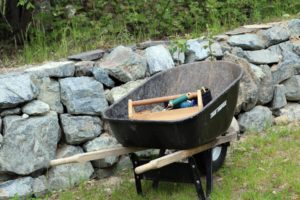A Book as Old as Dirt
Years ago, at Powell’s Book Store in Portland, I happened upon a used book called The Wise Garden Encyclopedia. Its weight was substantial but not unwieldy and it felt good the way some books do, to hold in my hands. In small type on glossy paper, with a smattering of excellent pen and ink illustrations (but poor quality photos), the book held a cornucopia of in-depth gardening facts and advice. While the original copyright had been 1936, this edition heralded from 1965. The dust jacket had a photograph of a woman pruning red roses in her garden wearing white shoes and a white dress with a floral apron. No joke. The original price for the book appeared to be $5.95. I happily laid down $20 to take it home.
substantial but not unwieldy and it felt good the way some books do, to hold in my hands. In small type on glossy paper, with a smattering of excellent pen and ink illustrations (but poor quality photos), the book held a cornucopia of in-depth gardening facts and advice. While the original copyright had been 1936, this edition heralded from 1965. The dust jacket had a photograph of a woman pruning red roses in her garden wearing white shoes and a white dress with a floral apron. No joke. The original price for the book appeared to be $5.95. I happily laid down $20 to take it home.
Since then, The Wise Garden Encyclopedia has been my go-to guide for all horticultural questions and endeavors. I saved the dust jacket in a Ziploc bag and to this day use the sturdy green hard-bound book when and however it’s needed. I have an entire shelf of gardening books, but Wise Garden is always the one with the answers. I have decided to transplant some ferns from a ditch near my house to the top of the rock wall that my son and grandkids helped to build last summer. I reached for the encyclopedia and was once again delighted by the book’s depth and also its poetry. The entry under “ferns” takes up seven of its 1,380 pages. And there in the midst of types of ferns, their uses and methods of propagation is a quote from Thoreau!
“Thoreau said, ‘Nature made ferns for pure leaves.’ And it is primarily for the great beauty of their leaves, the endless variety of forms, the range of subtle shades of green, that we treasure these plants.”
Be still my heart.
 Fifty-four varieties of ferns and horsetail are known to grow in Alaska. I am transplanting a northern wood fern, lifting it from the ditch and placing it where I can see it from my kitchen window. Wise Garden says to reset the plant facing the same way it was oriented in its original bed. Isn’t that something . . . how a plant can be sensitive to its orientation on the earth, or more specifically to its alignment with the moving sun? An entire universe in a plant. It seems maybe some life lessons could be learned from observing just this individual fern.
Fifty-four varieties of ferns and horsetail are known to grow in Alaska. I am transplanting a northern wood fern, lifting it from the ditch and placing it where I can see it from my kitchen window. Wise Garden says to reset the plant facing the same way it was oriented in its original bed. Isn’t that something . . . how a plant can be sensitive to its orientation on the earth, or more specifically to its alignment with the moving sun? An entire universe in a plant. It seems maybe some life lessons could be learned from observing just this individual fern.
The book also says that “some ferns are valuable for attracting birds because of the woolly substance which clothes the uncoiling fronds and is much prized as nesting material.” The language of the book itself is like sweet fruit, delicious and ripe for the picking. Oh yes, and that was the other thing I’d hoped to place on the rock wall this year — a bird feeder.
It is summer, and plans abound. As daylight increases, energy and ambitions soar. Yes, there will be the beginnings of a garden, even if just in pots this year. I’ll transplant ferns and maybe put in some berry bushes. My son has given me some apple trees that he grafted himself from Siberian stock. Those should go in the ground this year as well. For these and other projects, Wise Garden will be there. like an old glove, worn and comfortable. Just for kicks I googled “transplanting ferns” and the omniscient “G” came back with 98,000 entries. I like the internet for its
 research capabilities; on a daily basis I have the world’s library at my fingertips. But a quick cruise of the top few of those 98,000 entries felt like a cheap and entirely unsatisfactory substitute for the heft and grace of Wise Garden.
research capabilities; on a daily basis I have the world’s library at my fingertips. But a quick cruise of the top few of those 98,000 entries felt like a cheap and entirely unsatisfactory substitute for the heft and grace of Wise Garden.
The book feels as old as dirt which is, after all, the substance of the garden itself.
I’ve always wondered about that book on your shelf…
I inherited a copy of “The Wise Garden Encyclopedia” that belonged to my great-grandmother. The title page is missing, but I believe that my book is the 1959 edition. My Grandma Smith was an avid gardener who raised beautiful flowers in her garden by the sea in Ocean Lake, Oregon (now Lincoln City) during the 1950’s and 1960’s. It is a remarkable reference book.